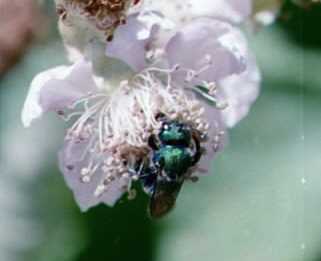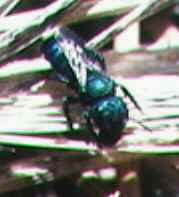![]()
Pollinator Paradise Pollination
Ecology at UI The
Solitary Bee Web
Rearing Solitary Bees
Suppliers References
Bee Gardens FAQ
Links Contact
Us
New Mexico Native Bee Pollinator Project About
Dr. Strickler
Bee Nests and Accessories Bee Photo
Gallery
Trapnesting Wasps and
Bees
![]()
Table of Contents (Scroll down):Announcements
Want to see more photos of Osmia? Try these sites: |
 Have
you seen this bee? Have
you seen this bee?Osmia aglaia on Himalayan Blackberry near Medford, OR O. aglaia is a pollinator of brambles, including raspberries and blackberries, in western Oregon and California. We don't know if their range extends through western Washington, including the Seattle area, and north. We are working with a Berry Grower in Oregon to increase managed populations of this bee for berry pollination. Read about our project. |

O. aglaia are metallic blue, green or rust/bronze in color. They nest in tunnels in wood about 3/8 - 1/4 inches in diameter. They are active as adults in late spring, while Rubus is in bloom. There is a developing market for native bee
pollinators. If you live on the west
coast and know of populations of Himalayan Blackberry. We may be able
to help with nesting materials. O. aglaia sunning |
Please read our
Announcements
Is
it a bee? The Logan bee lab helps you distinguish bees from
other similar insects.
A bee identification exercise to
try with master gardeners, kids and other groups.
Krombein's Trap-Nesting Wasps and Bees. On line! Read this classic study of twig nesting bees and wasps.
Follow our study to increase the Oregon Berry Bee, Osmia aglaia, for pollination of cane fruits. http://oregonberrybee.blogspot.com/
Read our Osmia management guide, including winter management of Osmia cocoons, and Feeding Osmia with sugar water when bloom is scarce. Download a 2009 Osmia management Calendar to print! (update for 2010 available in January).
A bee identification exercise to
try with master gardeners, kids and other groups.
Visit our Bee Photo Gallery
Need a gift for a Nature Lover?
Want to help conserve native bees?
Try our
BINDERBOARD®!
Click to
Learn more.
Books on Osmia
management; large and small nests; nest liners.
Learn more about native bees;
get involved in a world-wide pollination
project:
The Great Sunflower
Project, (San Francisco State University)
Concerned about colony collapse disorder? What can you do to help pollinators? See our FAQs.
Are you managing native blue orchard bees, introduced hornfaced bees, or both? We are trying to determine how well established hornfaced bees are, especially in the western USA. If you have hornfaced bees, please contact us and let us know where you are, how many you have, and what proportion of your orchard bees are hornfaced bees. For information on how to distinguish nests and cocoons of the two types of orchard bees, click here.
Need additional blueberry pollinators? Try
alfalfa leafcutting bees.
Hornfaced bees, Osmia cornifrons, allegedly also work. In our
experience Blue Orchard Bees, Osmia lignaria, in the Portland area and in
Washington State are more attracted to Big leaf Maple, Acer macrophyllum,
than to blueberry. Please let us know what your experience has been with
alternative blueberry pollinators.
Blue orchard bees are excellent
cherry pollinators .
Try setting out
artificial nests with a variety of hole sizes, and see what twig-nesting bees
are present in your area already.
Should bee species be
moved across country or between countries? Read about the issues : "For Nonnative Crops, Whence
Pollinators of the future?"
Is
it a bee? The Logan bee lab helps you distinguish bees from other
similar insects.
A bee identification exercise to
try with master gardeners, kids and other groups.
Pollinator Paradise Bee Photo Gallery
The hornfaced bee, Osmia cornifrons, is widely used in Japan for apple pollination. It was imported to the US and is being used particularly in Eastern and Midwestern states. The orchard mason bee, also called the Blue Orchard Bee, Osmia lignaria, is a native US species found in most parts of the country, and also widely used for orchard pollination. These Osmia bees are more efficient pollinators of some crops than are honey bees. Pollination of an acre of apples requires either 600 hornfaced bees (300 to 400 females), about 250 female blue orchard bees, or 20,000 or more honey bees. These bees are called "solitary" bees because they do not live in colonies as do honey bees. Solitary bees do not produce honey or wax, but they are relatively docile and not apt to sting, they are immune from tracheal and varroa mite attack, and they can be reared quite easily by homeowners and farmers.
Top of Page| Diversify With Pollen Bees (Suzanne Batra, 1994) | |
| The NBII (National
Biological Information Infrastructure)
Pollinators Project including information about bees and wasps | |
| The Bug Guide's bee pages. Lots of great photos. Visit the other tabs at the top of the site for taxonomy and other information | |
| The Great Sunflower Project, (San Francisco State University) bee guides | |
| Solitary Bees for Orchard Pollination (Suzanne Batra, 1997) | |
| Pollen bees are world-wide! See a list of bees that pollinate alfalfa in Russia. | |
| Some Science Projects for Kids and Teens | |
| The New Mexico Native Bee Pollinator Project | |
| Solitary Bees and Things - Nigel Jones, focus on bees in Britain | |
| Understanding Native Bees - University of Maine Bulletin |
Rearing and Using Hornfaced Bees and
Orchard Mason Bees = Blue Orchard Bees
| Management of Hornfaced Bees for Orchard Pollination - A Practical Manual (Suzanne Batra, 1997) | |
| Bosch, J. and W. Kemp. 2001. How to Manage the Blue Orchard Bee, Sustainable
Ag. Network Handbook series, Book 5. This book has excellent color photos, lots of details, and especially good sections on parasites and predators, and on incubation and emergence. Excellent if you know these bees; a bit technical for a beginner. Now available free in PDF format at the SARE website: http://www.sare.org/publications/bob.htm | |
| A Pictorial Guide to Orchard Bee Management (Karen Strickler, 5/2005) | |
| Feeding Osmia with sugar water when bloom is scarce. (Steve Dupey, 2009) | |
| A Bee Garden for Attracting Osmia (Karen Strickler, updated 12/07/00) | |
| How to Raise and Manage Orchard Mason Bees for the Home Garden (North Carolina State Univ., 1997) | |
| A Note on the Proper Hole Size for Blue Orchard Mason Bee, Osmia lignaria, Management (Phil Torchio, 1996) | |
| How to Make a Nesting Block (USDA/ARS Bee Labs, Logan UT) | |
| A Few References of Interest to Bee Lovers (Karen Strickler, updated 12/07/00) | |
| Texas A&M video on hornfaced bees | |
| Orchard Mason Bees (Washington State University.) | |
| FAQ: The bees that I purchased were lethargic when they emerged. What was wrong? Recent research provides an answer. | |
| FAQ: Mites are killing my orchard bees. Are they the same mites that affect honey bees? What can I do? |
Suppliers
| Suppliers of Pollen Bees, Information, and Products (Karen Strickler, updated December 2004) |
Notes and Correspondence from Readers
| Forsythia Might be a Nectar Source (Diane De Young, April, 1998) | |
| 1997 Early-Season Experiences Rearing Hornfaced Bees in West Virginia (May 31, 1997) | |
| Ongoing West Virginia Investigations into the Hornfaced Bee for Orchard Pollination (May 31, 1997) | |
| Honey as a Supplemental Food Source for Hornfaced Bees (Bill Mack, April 25, 1997) | |
| Keeping out tiny Monodontomerus wasp parasites (Raymond Williams, January 1999) | |
| Blue orchard bees increase cherry yields (Robert White, January 2006) |
Other Information on the Web
| The Pollination Homepage (Dave and Janice Green) Includes excellent photo gallery. | |
| Forgotten Pollinators Campaign (Arizona-Sonora Desert Museum) | |
| Beehoo (links to bee webpages around the world) | |
| The Pollination Ecology web (Alfalfa pollination, management of leafcutting bees, research philosophy) | |
| The Bee Works (Pollination related services from Steve Buchmann and colleagues) | |
| The Xerces Society (Pollinator Conservation Program) | |
| Is it a bee? The Logan bee lab helps you distinguish bees from other similar insects. | |
| Stinging Insects: Aacute Pest Control's web site. Info about and photos of social wasps, carpenter bees, bumble bees, etc. | |
| Stinging insect fact sheets from Cornell University | |
| Frequently asked questions about honey bees and insects in general from UC Riverside | |
| Honey bees, other bees, pollination, bee pastures, etc., from the University of Georgia. |
Additional/Alternate Pollinators
| USDA/ARS / Logan Bee Lab | |
| Penn State University video about using native bees for orchard pollination. Click here to see it. | |
| Knox Cellars (Orchard Mason Bee supplier) | |
| Pollination for the Home Gardener (Howard Veatch) | |
| Alternative Pollinators - Native Bees (ATTRA site) | |
| BeeDiverse (mason bees and easy to manage nesting trays) | |
| Texas A&M video on hornfaced bees | |
| Small Carpenter Bees, Ceratina (University of Florida) | |
| Solitary Bees and Things - Nigel Jones, focus on bees in Britain | |
| Management of alfalfa leafcutting bees for blueberry pollination (New Brunswick, CA) | |
|
Understanding Native Bees - University of Maine Bulletin |
More suppliers on the supplier's list
| Plants of Interest to Bumblebees (go to Tom Clothier's Website) | |
| Constructing Bumblebee Nest Boxes (go to Tom Clothier's Website) | |
| Another set of plans for Bumblebee nest boxes (beetools Website) | |
| The Wisconsin Bumblebee (go to Paul Oliphant's Website) | |
| Laura Smith's Bumblebee Pages | |
| List of World Bumblebees (Paul Williams, The Natural History Museum, London) | |
| Bumblebees of Washington (Evergreen State University) | |
| Bumble bees of Utah (USDA ARS Bee Biology and Systematics Lab, Logan UT) | |
| The Bees of Maritime Canada (Ag. & Agri. Food Canada, Kentsville, Nova Scotia) |
| Carl Hayden Bee Research Center (GEARS) | |
| Bee Resource Manual with Emphasis on the Africanized Honey Bee (Armed Forces Pest Mgt. Board) | |
| Essential Oils for Mite Control (West Virginia University) | |
| Bee Pollination of Crops in Ohio (Ohio State Univ.) | |
| List of Beekeeping Resources (Iowa State Univ.) | |
| Bee Research Laboratory (USDA-ARS) | |
| Beekeeping Tips (Mississippi State Univ.) | |
| Texas A&M honeybee information | |
| Penn State honeybee lab | |
| Mid-Atlantic Apiculture Consortium | |
| Africanized Bees in California (UC Riverside) | |
| Adkins Bee Removal (CA, AZ, NV, TX) |
![]()
 Site maintained by
Karen Strickler, pollination ecologist.
Site maintained by
Karen Strickler, pollination ecologist.
Send your comments and questions
For more information, contact:
| Karen Strickler, Pollination Ecologist 31140 Circle Dr. Parma ID 83660 email Dr. Strickler |
Dr.
Suzanne Batra USDA ARS Beltsville Agricultural Research Center Beltsville, Maryland 20705 |
Tell us where you live, whether you have tried solitary bees, and if so, what success you have had. Send photos of your bee management techniques to Dr. Strickler, at the above e-mail address.
When contacting Dr. Batra, please include your postal mailing address so that she can send printed information. This will also provide her some climatic information so that she can offer more localized advice.
![]()
Top of Page Pollinator Paradise Pollination
Ecology at UI The
Solitary Bee Web
Rearing Solitary Bees
Suppliers References
Bee Gardens FAQ
Links
Contact
Us
New Mexico Native Bee Pollinator Project About
Dr. Strickler
Bee Nests and Accessories Bee Photo
Gallery
Trapnesting Wasps and
Bees
![]()
Updated Dec. 6, 2014
Copyright ©
2000 Karen
Strickler. All rights reserved.